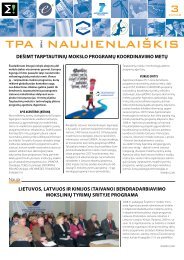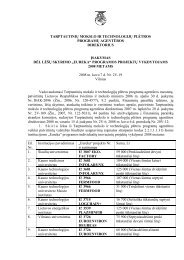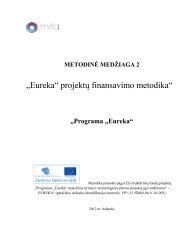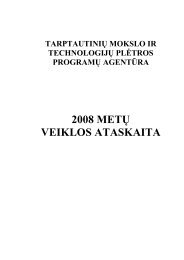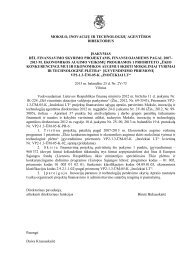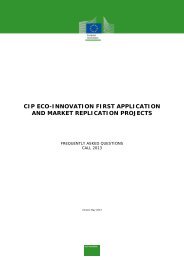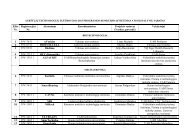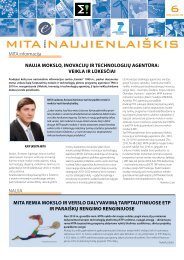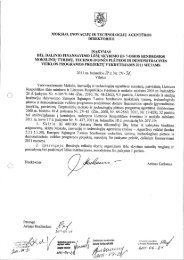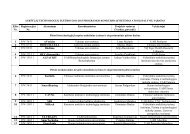Evaluation process and lessons learnt for applicants
Evaluation process and lessons learnt for applicants
Evaluation process and lessons learnt for applicants
Create successful ePaper yourself
Turn your PDF publications into a flip-book with our unique Google optimized e-Paper software.
<strong>Evaluation</strong> <strong>process</strong> <strong>and</strong><strong>lessons</strong> <strong>learnt</strong> <strong>for</strong> <strong>applicants</strong>Maria HabichtEstonian Research CouncilMay 28, 2013Kaunas
Overview of the <strong>Evaluation</strong> ProcessSubmissionIndividualreadingConsensusPanelFinalisationFull ProposalEvaluatorsEvaluatorsEvaluatorsFinal rankinglistProposal<strong>for</strong>msEligibilityCriteriaCriteriaCriteriaProposals insuggestedpriority orderRejection listCOMMISSIONCOMMISSION2Role of experts
Preliminary eligibility check be<strong>for</strong>e yourproposal is given to the evaluators:The proposal must meet ALL requirements of the call, whichmeans: It is submitted be<strong>for</strong>e the deadline You have at least the minimum number of participants You have filled in <strong>and</strong> completed all required <strong>for</strong>ms, bothadministrative (A) <strong>and</strong> the description of work (B) You have understood the work programme correctly <strong>and</strong>your proposal corresponds to the call <strong>and</strong> the topic You have used the correct funding scheme You have followed all special clauses, limitations <strong>and</strong>additional requirements written down in the workprogramme of the call Your budget is within the allowed limits
Selection of experts• Based on:– A high level of expertise– An appropriate range of competences• If the above conditions can be satisfied, then also:– Balance academic/industrial– Gender– Geography– Rotation• But also, of course, constrained by:– avoidance of conflicts of interest4
https://ec.europa.eu/research/participants/portal/page/experts
<strong>Evaluation</strong> Scores (1)• <strong>Evaluation</strong> scores are awarded <strong>for</strong> each of the three criteria,<strong>and</strong> not <strong>for</strong> the sub-criteria• The relevance of a proposal is considered in relation to thetopic(s) of the WP open in a given call, <strong>and</strong> to the objectivesof a call.• When a proposal is partially relevant ….. this condition isreflected in the scoring of the first criterion.• Proposals that are clearly not relevant to a call ("out ofscope") will be rejected on eligibility grounds.• Each criterion is scored out of 5. Half marks can be given.• Thresholds are applied to the scores. The threshold <strong>for</strong>individual criteria is 3.• The overall threshold, applying to the sum of the threeindividual scores, is 10.
<strong>Evaluation</strong> Scores (2)0 - The proposal fails to address the criterion under examination or cannot bejudged due to missing or incomplete in<strong>for</strong>mation1 - Poor. There are serious inherent weaknesses in relation to the criterion inquestion.2 - Fair. While the proposal broadly addresses the criterion, there aresignificant weaknesses that would need correcting.3 - Good. The proposal addresses the criterion well, although improvementswould be necessary.4 - Very good. The proposal addresses the criterion very well, althoughcertain improvements are still possible.5 - Excellent. The proposal successfully addresses all relevant aspects ofthe criterion in question. Any shortcomings are minor.
May be “remote”For each proposal:Proposal Xcopy 1IERexpert 1Proposal Xcopy 2IERexpert 2ConsensusmeetingCR3 expertsProposal Xcopy 3IERexpert 3Note: There may be more than 3 evaluators
Criteria• Criteria adapted to each funding scheme– specified in the work programme9• Three main criteria:– S&T Quality (relevant to the topic of the call)• Concept, objective, progress beyond state-of-art,work-plan– Implementation• Management• Individual participants <strong>and</strong> consortium as a whole• Allocation of resources– Impact• Contribution to expected impacts listed in workprogramme• Plans <strong>for</strong> dissemination/exploitation
Comparison of Proposal with<strong>Evaluation</strong> CriteriaProposal: Part B<strong>Evaluation</strong> Criteria1: Scientific <strong>and</strong>/or technicalquality, relevant to the topicsaddressed by the callScientific <strong>and</strong>/or technologicalexcellence (relevant to the topicsaddressed by the call)1.1. Concept <strong>and</strong> objectives Soundness of concept, <strong>and</strong> qualityof objectives1.2. Progress beyond the state-ofthe-art1.3. S/T methodology <strong>and</strong>associated work planProgress beyond the state-of-theartQuality <strong>and</strong> effectiveness of the S/Tmethodology <strong>and</strong> associated workplan
Proposal: Part B<strong>Evaluation</strong> Criteria2. Implementation Quality <strong>and</strong> efficiency of theimplementation <strong>and</strong> the management2.1. Management structure <strong>and</strong>proceduresAppropriateness of the managementstructure <strong>and</strong> procedures2.2. Individual participants Quality <strong>and</strong> relevant experience of theindividual participants2.3. Consortium as a whole Quality of the consortium as a whole(including complementarity, balance)2.4. Resources to be committed Appropriateness of the allocation <strong>and</strong>justification of the resources to becommitted (budget, staff, equipment)
Proposal: Part B<strong>Evaluation</strong> Criteria3. Impact Potential impact through thedevelopment, dissemination <strong>and</strong> useof project results3.1 Expected impacts listed in thework programme3.2 Dissemination <strong>and</strong>/or exploitationof project results, <strong>and</strong> management ofintellectual propertyContribution, at the European [<strong>and</strong>/orinternational] level, to the expectedimpacts listed in the work programmeunder the relevant topic/activity.Appropriateness of measures <strong>for</strong> thedissemination <strong>and</strong>/or exploitation ofproject results, <strong>and</strong> management ofintellectual property.
The Final Panel• Key function is to ensure consistency• Final marks <strong>and</strong> comments <strong>for</strong> each proposal– <strong>Evaluation</strong> Summary Reports (ESR)– Any new scores (if necessary)– Guidance <strong>for</strong> contract negotiation• Ranking proposals with identical consensus scores– Approach is spelled out in Work Programme <strong>and</strong> Guide <strong>for</strong> Applicants• Resolve cases if a minority view was recorded in consensus stage• [Exceptionally] recommendations <strong>for</strong> combining• List of proposals <strong>for</strong> priority order• Hearings (if applicable)13
ProposalsThe ranked listLimit of budgetThreshold scoreScore1514131211109876543210FundedRejected*Rejected*unless selected via a reserve list
Quality assurance• Expert questionnaire• Independent observers• Redress procedure• Internal Audit15
Tips <strong>and</strong> advice• Write clearly & simply Don’t use jargon/abbreviations/acronyms/obscureterms Evaluator may not be a native English speaker• Do not assume knowledge/specific expertise ofevaluators• Use diagrams <strong>and</strong> charts to illustrate your proposal Pictures are often worth a thous<strong>and</strong> words!• Keep within guidelines <strong>for</strong> text length• Stay within scope Refer back to Call Text & WP on a regular basis• Ensure proposal does not duplicate previous projects,but builds on them!16
Tips <strong>and</strong> advice• FP is highly competitive: the average success rate is 21% -But it is not a lottery!• Read the documentation (work programme, call fiche, guides<strong>for</strong> <strong>applicants</strong>) - No hidden agenda!• Prepare yourself in good time• Check the eligibility criteria• You must align your proposal with the work programme• “Shoe-horning” a marginally relevant proposal into callnever works!• Don’t <strong>for</strong>get the ‘expected impact’• Follow the structure in the Guide <strong>for</strong> Applicants17
Tips <strong>and</strong> advice• Put yourself in the mind of the experts• Ask a disinterested colleague look at your proposal,using the Commission criteria• Be clear <strong>and</strong> concise, <strong>and</strong> obey the page limits, fontsize etc• Submit early, submit often! Revise your proposal once it’s uploaded in EPPS18• The experts’ evaluation is based on the content of theproposal. So be clear <strong>and</strong> logical concerning progressbeyond state of the art, impacts, methodology,resources, consortia <strong>and</strong> work planning.
Finally• Abstract is a very important part of your proposal• Evaluators are allocated ½ day [4 hours] to read,underst<strong>and</strong> <strong>and</strong> report on 60-100 pages of text!• Your project idea may be brilliant, HOWEVER, firstimpressions count!Be aware that it is a competition!!19
http://cordis.europa.eu/fp7/experts_en.html
Practical exercise – group work1. Read the abstract <strong>and</strong> the evaluation report2. Consult the text of the Work Programme3. Give a mark <strong>for</strong> each criteria4. Discuss the marks within your group <strong>and</strong> try to reacha consensus




